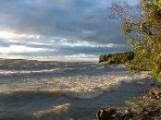Kempenfelt Bay - Ice fishing Mecca
Every winter, thousands of devoted anglers brave the elements to stake claim to holes cut in Lake Simcoe's frozen surface and patiently await the big catch.
It's a tradition that's been around for a long, long time.
Some 3,000 years ago, before the ancient Greek or Roman civilizations rose to prominence, prehistoric native peoples had ventured out on the ice to fish Lake Simcoe's plentiful stocks of herring, trout, muskellunge, and pike. Originally equipped with nothing more than a simple spear with which to impale their prey, the native peoples eventually developed a sophisticated understanding of fish habits and manufactured effective decoys, with moving fins, designed to attract fish to within spear range.
Ice fishing became an integral part of the lifestyle of local Indians, proving vital to maintaining food stores over lengthy winters. From them, the first European settlers learned the secrets of fishing through the ice. In the early years, before their farms were well and truly established, ice fishing was only marginally less important to the European settlers than it was for the native peoples before them. Winter diets, without supplements drawn from the depths of the lake, could be slender.
As the years passed, ice fishing evolved in sophistication, and was transformed from a viable industry to become more of a sport.
Originally, anglers had only jackets and layers of fur, or perhaps a simple windscreen, to protect themselves from the elements. In the late 19th and early 20th centuries, however, wooden windbreaks and portable huts began to appear, dotting the ice across Kempenfelt Bay. Some of the more elaborate huts were covered with tarpaper, and featured stoves made from old oil drums.
In 1908, there were fewer than 100 huts on the bay, and most were occupied by local individuals still earning supplemental incomes from their catch (lake trout and herring went for five cents a pound, for example). Fishing was almost entirely by spear at this early stage.
Spear fishing was outlawed in 1941 over concerns that trout were being speared during their vulnerable spawning periods, though illegal spearing remained a problem well into the 1950s.
Spear fishing was replaced by the modern line method, which traditionalists considered much less sporting at the time.
Nevertheless, ice fishing continued to enjoy a swell in popularity. By 1949, there were more than 500 ice huts on Kempenfelt Bay. Most fishermen were now Toronto residents, who made the journey north on weekends, and the commercial ice-fishing industry was almost extinct save for a few diehards.
Ice fishing had completed the evolution from necessity to recreation, from niche activity to mainstream hobby.
Over the decades that followed, ice fishing became more sophisticated and organized, the businesses catering to it grew in size and importance to the local economy, and its popularity soared.
Perhaps the only thing that has changed is the zeal for roughing it in the cold. Today, ice huts are outfitted with all the comforts of modern life - radios, heaters, comfortable chairs, televisions, and stoves.




1 Comments:
huaraches sale
tiffany and co uk
mlb jerseys authentic
http://www.chromehearts.com.co
michael kors outlet store
ray ban sunglasses outlet
Michael Kors Purses
ray ban sunglasses
true religion store
michael kors outlet online
tiffany and co jewellery
cheap basketball shoes
nike kobe sneakers
Michael Kors Outlet Online
michael kors handbags outlet
http://www.michaelkors-outletfactory.us.com
mlb jerseys authentic
michael kors outlet online
tiffany jewelry
http://www.raybanglasses.in.net
michael kors outlet
chrome hearts online store
ray ban uk,cheap ray ban sunglasses
toms outlet
huaraches shoes
cheap tiffanys
Post a Comment
<< Home